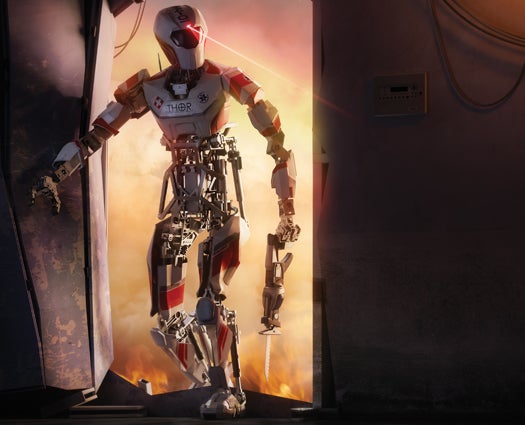Now Live: The February 2013 Issue Of Popular Science Magazine
Jacob Ward, editor-in-chief of Popular Science, has some questions about humanoid rescue robots.

In 2010, I had the pleasure of writing our cover story about CHARLI-L, the first bipedal, self-contained robot built in the United States. It was rickety, cheap, and extraordinary. Engineering such a thing is incredibly hard.
Dennis Hong and his team at Virginia Tech were working from the premise that the best way to adapt a robot to a human environment is to mimic the human form. That way it can reach our cabinets and move fluidly through our homes. Now Hong and his team are trying to make something far more complex. This December, as you’ll read in our cover story, CHARLI-L’s descendant, a bulked-up, ruggedized prototype called THOR, will attempt the eight disaster-response tasks that make up the DARPA Robotics Challenge. No humanoid has managed these tasks before. Few can even wobble around a flat, stable surface. The idea that a robot is going to wield a saw or drive a truck next year is, well, audacious.
Why is it that when gusts of fire are curling off our roof, the device we want to send in is one that looks like us?For me, the idea of a humanoid rescuer raises several questions. Why is it that when gusts of fire are curling off our roof, the devices we want to send in to rescue our families are ones that look like us? I have a friend who was leaving his apartment near the Twin Towers when they collapsed in 2001. He and his wife, blinded by the dust, had to literally crawl to the edge of Manhattan, where they managed to catch a ride on a fleeing pleasure boat. Yet he feels he wasn’t close enough to 9/11 to understand it. Is that what this humanoid thing is? Are we so dissatisfied by our relationship to danger that the only solution is to build a hardier version of ourselves that can get closer to it?
And another thing: If I’m lying there with a burning ceiling beam across my broken leg, will I be relieved when a humanoid robot reaches through the smoke for me, or will it drive me into shock? Stanford’s Clifford Nass, who received NSF funding to study this very thing, says that he and Robin Murphy of Texas A&M are weighing, for instance, whether it’s more comforting when the robot is a proxy for a human rescuer (“Hello, I’m controlling this robot from a block away”) or whether the robot should be itself (“Hello, I’m THOR!”).
But hey. Whatever form the winner of the DARPA challenge takes, I’m just glad that someone’s building a robot that goes where human rescuers can’t. When I need to be carried out of the inferno, I bet I won’t care what shape the arms are.
–Jacob Ward
jacob.ward@popsci.com | @jacobward
Go here to read the February issue of Popular Science.